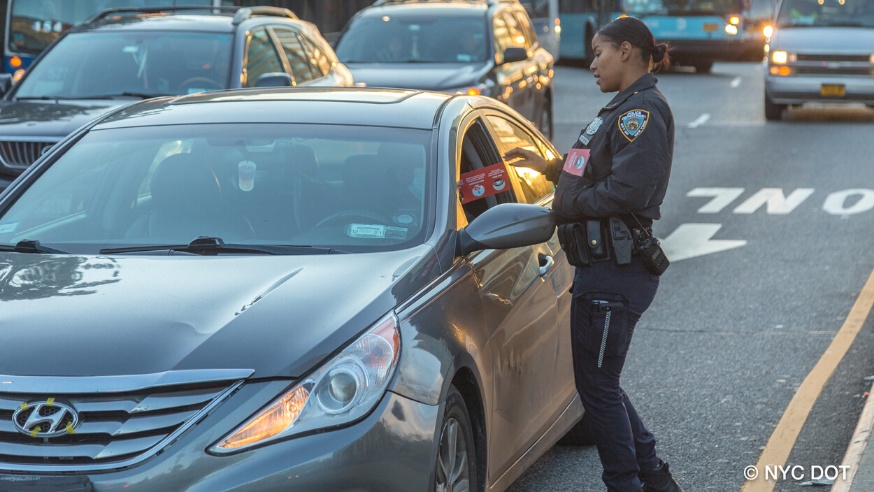
A police officer informing a motorist about the increased dangers of driving during the darker months (Photo: DOT)
Nov. 8, 2021 By Michael Dorgan
The city has relaunched an annual traffic safety initiative to help protect road users during the fall and winter—with the clocks having been pushed back an hour.
The Dusk and Darkness campaign, which aims to remind motorists of the increased dangers of driving over the darker months, was announced by Mayor Bill de Blasio and other city officials Thursday. The campaign places a big emphasis on keeping pedestrians and cyclists safe from collisions with vehicles.
The announcement was made before the clocks were pushed back by one hour Sunday—marking the end of Daylight Savings Time and the beginning of darker evenings.
The campaign, now in its sixth year, urges drivers to be more careful during dusk and evening rush hours since visibility will be reduced. The reduced lighting, officials say, increases the dangers motorists pose to pedestrians and cyclists.
“As the sun sets earlier, drivers have an extra responsibility to slow down,” de Blasio said. “The Dusk and Darkness program combines education and enforcement to make sure they do just that.”
As part of this year’s campaign, police and the Dept. of Transportation have been at high-visibility areas across the city educating drivers about the increased risk of traffic collisions during the morning and evening hours.
Signs and awareness information have been put up by the DOT on bus shelters, LinkNYC kiosks and on print advertising.
Road traffic enforcement has also been ramped up by police in areas where pedestrians and cyclists are most likely to be injured by vehicles. Cops are targeting motorists who speed or fail to yield to pedestrians and cyclists.
The late fall and winter period has historically been the most dangerous time of the year for pedestrians and cyclists, according to DOT data.
Serious collisions involving pedestrians were 40 percent higher – during the late fall and winter period -in the five years before the campaign launched in 2016, according to DOT data.
City officials credited the campaign for a reduction in pedestrian fatalities over the last five years. Pedestrian fatalities were down 18 percent on average during the evening and overnight hours during the months of November through March, according to the data.
The campaign was created as part of the mayor’s Vision Zero initiative which aims to eliminate all traffic fatalities across the five boroughs by 2024.






